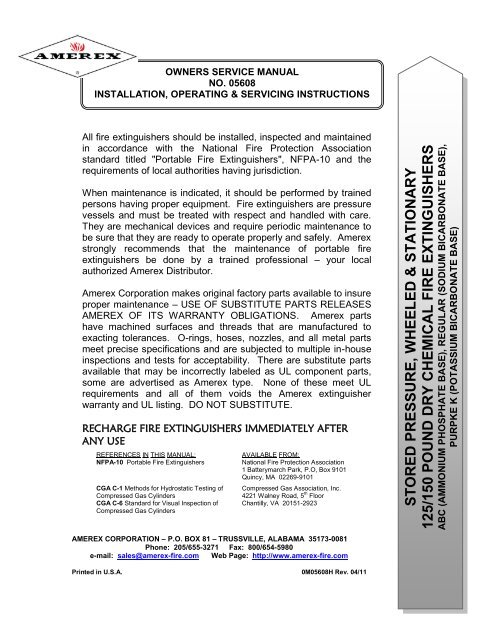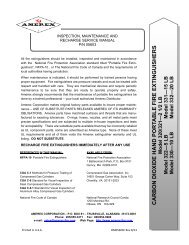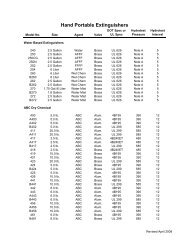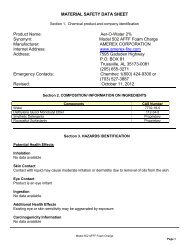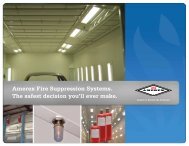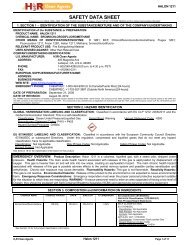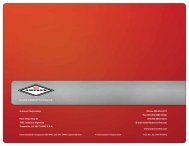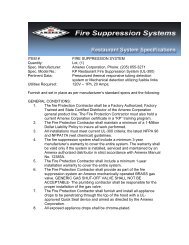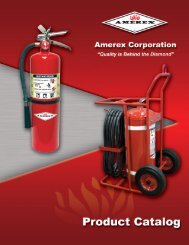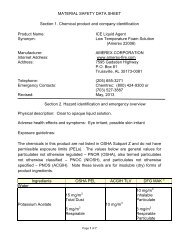Manual for 125-150 lb Stored Pressure - Amerex Corporation
Manual for 125-150 lb Stored Pressure - Amerex Corporation
Manual for 125-150 lb Stored Pressure - Amerex Corporation
Create successful ePaper yourself
Turn your PDF publications into a flip-book with our unique Google optimized e-Paper software.
OWNERS SERVICE MANUAL<br />
NO. 05608<br />
INSTALLATION, OPERATING & SERVICING INSTRUCTIONS<br />
All fire extinguishers should be installed, inspected and maintained<br />
in accordance with the National Fire Protection Association<br />
standard titled "Portable Fire Extinguishers", NFPA-10 and the<br />
requirements of local authorities having jurisdiction.<br />
When maintenance is indicated, it should be per<strong>for</strong>med by trained<br />
persons having proper equipment. Fire extinguishers are pressure<br />
vessels and must be treated with respect and handled with care.<br />
They are mechanical devices and require periodic maintenance to<br />
be sure that they are ready to operate properly and safely. <strong>Amerex</strong><br />
strongly recommends that the maintenance of portable fire<br />
extinguishers be done by a trained professional – your local<br />
authorized <strong>Amerex</strong> Distributor.<br />
<strong>Amerex</strong> <strong>Corporation</strong> makes original factory parts available to insure<br />
proper maintenance – USE OF SUBSTITUTE PARTS RELEASES<br />
AMEREX OF ITS WARRANTY OBLIGATIONS. <strong>Amerex</strong> parts<br />
have machined surfaces and threads that are manufactured to<br />
exacting tolerances. O-rings, hoses, nozzles, and all metal parts<br />
meet precise specifications and are subjected to multiple in-house<br />
inspections and tests <strong>for</strong> acceptability. There are substitute parts<br />
available that may be incorrectly labeled as UL component parts,<br />
some are advertised as <strong>Amerex</strong> type. None of these meet UL<br />
requirements and all of them voids the <strong>Amerex</strong> extinguisher<br />
warranty and UL listing. DO NOT SUBSTITUTE.<br />
RECHARGE FIRE EXTINGUISHERS IMMEDIATELY AFTER<br />
ANY USE<br />
REFERENCES IN THIS MANUAL: AVAILABLE FROM:<br />
NFPA-10 Portable Fire Extinguishers National Fire Protection Association<br />
1 Batterymarch Park, P.O, Box 9101<br />
Quincy, MA 02269-9101<br />
CGA C-1 Methods <strong>for</strong> Hydrostatic Testing of Compressed Gas Association, Inc.<br />
Compressed Gas Cylinders 4221 Walney Road, 5 th Floor<br />
CGA C-6 Standard <strong>for</strong> Visual Inspection of Chantilly, VA 20151-2923<br />
Compressed Gas Cylinders<br />
AMEREX CORPORATION – P.O. BOX 81 – TRUSSVILLE, ALABAMA 35173-0081<br />
Phone: 205/655-3271 Fax: 800/654-5980<br />
e-mail: sales@amerex-fire.com Web Page: http://www.amerex-fire.com<br />
Printed in U.S.A. 0M05608H Rev. 04/11<br />
STORED PRESSURE, WHEELED & STATIONARY<br />
<strong>125</strong>/<strong>150</strong> POUND DRY CHEMICAL FIRE EXTINGUISHERS<br />
ABC (AMMONIUM PHOSPHATE BASE), REGULAR (SODIUM BICARBONATE BASE),<br />
PURPKE K (POTASSIUM BICARBONATE BASE)
THIS MANUAL IS ATTACHED TO EVERY NEW EXTINGUISHER SHIPPED FROM THE FACTORY. IT<br />
CONTAINS VALUABLE INFORMATION WHICH SHOULD BE STUDIED BY EVERYONE WHO WILL USE OR<br />
SERVICE THE EXTINGUISHER. THE MANUAL SHOULD BE STORED IN A CONVENIENT LOCATION FOR<br />
EASY REFERENCE.<br />
INTRODUCTION<br />
The <strong>Amerex</strong> Models 488 (ABC), 489 (Regular) & 490 (Purple K) <strong>Stored</strong> <strong>Pressure</strong> Wheeled and<br />
Models 476 (ABC), 477 (Regular) & 478 (Purple K) <strong>Stored</strong> <strong>Pressure</strong> Stationary Dry Chemical<br />
fire extinguishers are designed to provide larger volumes of dry chemical fire fighting agent<br />
than hand portable types <strong>for</strong> industrial applications. The wheeled version can easily be<br />
transported and operated by one person and in a stationary configuration and can be mounted<br />
in a small space. The cage type carriage provides protection <strong>for</strong> the operating valve, cylinder<br />
and hose assembly. Easy rolling 16 inch semi-pneumatic rubber tires assure minimum ef<strong>for</strong>t to<br />
quickly transport them through narrow spaces to a fire scene.<br />
Maximum protection from severe corrosive environment is af<strong>for</strong>ded by the <strong>Amerex</strong> corrosion<br />
resistant metal preparation and paint finish. The operating valve, handle, gauge guard, fill cap,<br />
house couplings and ball type shutoff are brass, or brass chrome plated <strong>for</strong> years of trouble<br />
free use. These models carry an <strong>Amerex</strong> warranty of six years – see full wording of the<br />
warranty below.<br />
Field recharging is possible utilizing maintenance/recharge equipment available through your<br />
<strong>Amerex</strong> Distributor. To provide optimum extinguisher reliability, recharging should be<br />
per<strong>for</strong>med by persons trained in fire extinguisher maintenance and servicing. This manual<br />
should be used as a guide <strong>for</strong> installing, operating and servicing this extinguisher. The best<br />
place to have your extinguisher serviced and recharged is your Authorized <strong>Amerex</strong> Distributor<br />
who has the professional experience and equipment to do it properly.<br />
SIX YEAR LIMITED WARRANTY<br />
<strong>Amerex</strong> warrants its fire extinguishers to be free from defects in material and workmanship <strong>for</strong> a<br />
period of six (6) years from the date of purchase. During the warranty period, any such defects<br />
will be repaired or the defective extinguisher replaced if only factory replacement parts and<br />
recommended service equipment have been used to service the extinguisher. This warranty<br />
does not cover defects resulting from modification, alteration, misuse, exposure to unusually<br />
corrosive conditions nor improper installation or maintenance. All implied warranties, including,<br />
but not limited to, warranties of fitness <strong>for</strong> purpose and merchantability, are limited to the timer<br />
periods as stated above. In no event shall <strong>Amerex</strong> Corp. be liable <strong>for</strong> incidental or<br />
consequential damages. Some states do not allow limitations on how long an implied warranty<br />
lasts or the exclusion or limitation of incidental or consequential damages, so that the above<br />
limitations or exclusions may not apply to you. <strong>Amerex</strong> Corp. neither assumes nor authorizes<br />
any representative or other person to assume <strong>for</strong> it any obligation or liability other than<br />
expressly set <strong>for</strong>th herein. This warranty gives you specific legal rights, and you may also have<br />
other rights which may vary from state to state. To obtain per<strong>for</strong>mance of the obligation of this<br />
warranty, write to <strong>Amerex</strong> Corp., P. O. Box 81, Trussville, AL 35173-0081 <strong>for</strong> instructions.<br />
1
AMEREX CORPORATION DOES NOT SERVICE, MAINTAIN OR RECHARGE FIRE EXTINGUISHERS.<br />
THIS MANUAL IS PUBLISHED AS A GUIDE TO ASSIST QUALIFIED SERVICE PERSONNEL IN THE<br />
INSPECTION, MAINTENANCE AND RECHARGE OF AMEREX FIRE EXTINGUISHERS ONLY. NO<br />
INSTRUCTION MANUAL CAN ANTICIPATE ALL POSSIBLE MALFUNCTIONS THAT MAY BE<br />
ENCOUNTERED IN THE SERVICE OF FIRE EXTINGUISHERS. DUE TO THE POSSIBILITY THAT PRIOR<br />
SERVICE PERFORMED ON THIS EQUIPMENT MAY HAVE BEEN IMPROPERLY DONE, IT IS<br />
EXTREMELY IMPORTANT THAT ALL WARNINGS, CAUTIONS AND NOTES IN THIS MANUAL BE<br />
CAREFULLY OBSERVED. FAILURE TO HEED THESE INSTRUCTIONS COULD RESULT IN SERIOUS<br />
INJURY.<br />
AMEREX ASSUMES NO LIABILITY FOR SERVICE, MAINTENANCE OR RECHARGE OF FIRE<br />
EXTINGUISHERS BY PUBLISHING THIS MANUAL.<br />
PREPARING YOUR NEW EXTINGUISHER FOR USE<br />
1. Examine the extinguisher <strong>for</strong> evidence of shipping damage. Notify the delivering carrier<br />
immediately if any damage is discovered.<br />
2. Remove all wrappings, straps and pallet retaining bolts.<br />
3. Check to insure that the hose connection to the operating valve and shut-off nozzle to the<br />
hose are tight.<br />
4. Check to insure that the shut-off nozzle is in the closed position. The ring (safety) pin<br />
should be installed in the operating valve and the lockwire (tamper) seal intact.<br />
5. Check to make sure that the cap is on the "bleeder valve" (located on the side of the<br />
extinguisher operating valve). The pressure seal is in the cap and it must be in place to<br />
prevent leakage.<br />
6. This extinguisher is shipped from the factory fully charged. Visually inspect the pressure<br />
gauge – the pressure should be in the green zone (240 psi ± approx. 10 psi range). The<br />
most accurate method to determine if the extinguisher is filled with the proper amount of<br />
chemical is to weigh the unit. The gross weight is indicated on the nameplate (label).<br />
NOTE: Slight pressure variances in the gauge reading may be found if<br />
the extinguisher has been subjected to extremes of heat or cold.<br />
High temperatures can cause high gauge readings and low<br />
temperatures, low readings. When in doubt, condition the<br />
extinguisher to 70ºF (21ºC) <strong>for</strong> several hours to obtain more<br />
accurate pressure gauge readings.<br />
7. Record the date the unit is being placed into service on the inspection tag and attach it to<br />
the extinguisher.<br />
INSTALLATION<br />
Do not place this extinguisher close to a potential fire hazard. <strong>Amerex</strong> recommends location no<br />
less than a 50 foot distance from the hazard while leaving an unobstructed access. Avoid<br />
placing it in an extremely hot or cold place. The operational temperature range <strong>for</strong> this<br />
extinguisher is -65º to +120ºF (-54º to +49ºC). The extinguisher should be adequately<br />
protected if temperatures outside of this range are anticipated. Keep the extinguisher clean<br />
and free from dirt, ice, chemicals and any contaminants which may interfere with its proper<br />
operation. Do not functionally test this fire extinguisher. (Testing or any use may cause the<br />
extinguisher to gradually lose pressure and become ineffective.)<br />
2
OPERATION<br />
NOTE: Persons expected to use this extinguisher should be trained in initiating<br />
its operation and in the proper fire fighting technique. Familiarize all<br />
personnel with this in<strong>for</strong>mation be<strong>for</strong>e an emergency occurs.<br />
1. Move the extinguisher to within approximately 50 feet of the fire site. Keep the extinguisher<br />
upright.<br />
CAUTION: This extinguisher must be operated in an upright position. If<br />
equipped with an optional tow loop and vehicle towed to the fire<br />
scene, remove from tow hitch and operate in a vertical position.<br />
2. Twist and pull ring pin. Open cylinder discharge valve by rotating (pulling) the handle valve<br />
lever toward the hose. The hose is now pressurized with chemical.<br />
3. Pull nozzle, with lever in the closed position, from the mount and extend the hose from the<br />
storage rack.<br />
4. Stand back 30 feet from the fire and aim the nozzle at base of flames nearest you. Open<br />
nozzle by pulling handle toward you (be prepared <strong>for</strong> a discharge recoil by holding the<br />
nozzle firmly).<br />
5. Sweep side to side across the base of the fire and past both edges. Progressively follow up<br />
until the fire is extinguished. Work the fire away from you while being alert <strong>for</strong> flashbacks.<br />
Move closer as the fire is extinguished but not so close as to scatter or splash the burning<br />
materials.<br />
6. When the fire is out, push the hose (discharge) lever <strong>for</strong>ward to the closed position. Stand<br />
by and watch <strong>for</strong> possible reignition.<br />
7. Evacuate and ventilate the area immediately after extinguishing the fire. The fumes and<br />
smoke from any fire may be hazardous and can be deadly.<br />
DISCHARGE TIME – 488/476 – 49 Seconds 489/477 – 60 Seconds 490/478 – 52 Seconds<br />
EFFECTIVE RANGE OF AGENT THROW IS 25 TO 40 FEET<br />
HOSE LENGTH – 50 FEET<br />
SHUTDOWN<br />
CAUTION: BEFORE PERFORMING THE SHUTDOWN PROCEDURE AND<br />
PREPARING TO MOVE THE EXTINGUISHER TO THE RECHARGE<br />
LOCATION, DETERMINATION MUST BE MADE THAT THE FIRE IS<br />
COMPLETELY EXTINGUISHED AND THERE IS NO DANGER OF A<br />
FLASHBACK.<br />
1. Tip the extinguisher to the horizontal position (resting on the carriage handle) and slowly<br />
rotate the cylinder discharge valve lever to the open position. Slowly push the hose<br />
(discharge) nozzle lever to the open position and be prepared <strong>for</strong> some chemical discharge.<br />
2. When all pressure has been evacuated from the extinguisher, return the hose (discharge)<br />
nozzle lever and cylinder discharge valve lever to the closed position.<br />
NOTE: These steps will allow easy depressurization of the extinguisher<br />
and clear the hose assembly with a minimal loss of remaining<br />
chemical.<br />
3. Return the extinguisher to the upright position. Coil the hose onto the storage rack and<br />
position the nozzle into the mount in preparation <strong>for</strong> transport to the recharge location.<br />
RECHARGE EXTINGUISHERS IMMEDIATELY AFTER ANY USE<br />
3
INSPECTING THE EXTINGUISHER<br />
This extinguisher should be inspected at regular intervals (monthly or more often if<br />
circumstances dictate) to insure that it is ready <strong>for</strong> use. Inspection is a "quick check" that a fire<br />
extinguisher is available and is in operating condition. It is intended to give reasonable<br />
assurance that the fire extinguisher is fully charged. This is done by verifying that it is in its<br />
designated place, that it has not been actuated or tampered with, and that there is no obvious<br />
physical damage or condition to prevent its operation.<br />
PERIODIC INSPECTION PROCEDURES<br />
(Monthly or more often if circumstances dictate)<br />
[NFPA-10] Periodic inspection of fire extinguishers shall include a check of at least the following items:<br />
1. Location in designated place.<br />
2. No obstruction to access or visibility.<br />
3. <strong>Pressure</strong> gauge reading or indicator in the operable range or position.<br />
4. Operating instructions on nameplate and facing outward.<br />
5. Safety seals and tamper indicators not broken or missing.<br />
6. Examination <strong>for</strong> obvious physical damage, corrosion, leakage, or clogged nozzle.<br />
7. Determine fullness by weighing.<br />
8. Wheels rotate freely.<br />
MAINTENANCE<br />
[NFPA-10] At least once a year or more frequently if circumstances require, maintenance<br />
should be per<strong>for</strong>med. Maintenance is a "thorough check" of the extinguisher. It is intended to<br />
give maximum assurance that a fire extinguisher will operate effectively and safely. It includes<br />
a thorough examination <strong>for</strong> physical damage or condition to prevent its operation and any<br />
necessary repair or replacement. It will normally reveal if hydrostatic testing or internal<br />
maintenance is required.<br />
MAINTENANCE – SERVICE PROCEDURE<br />
NOTE: THIS PROCEDURE WILL BE BEST ACCOMPLISHED WITH THE<br />
EXTINGUISHER IN AN UPRIGHT POSITION AND ON A LEVEL SURFACE.<br />
1. Clean extinguisher to remove dirt, grease or <strong>for</strong>eign material. Check to make sure that the<br />
instruction nameplate is securely fastened and legible. Inspect the cylinders <strong>for</strong> corrosion,<br />
abrasion, dents or weld damage. If any damage is found, hydrostatically test to factory test<br />
pressure 500 psi (3448 kPa), using the proof pressure method, in accordance with instructions<br />
in C-6 and NFPA 10. See proper method of depressurizing and reclaiming chemical in<br />
Recharge procedures.<br />
NOTE: WHEN CLEANING, AVOID USE OF SOLVENTS AROUND THE<br />
PRESSURE GAUGE. THEY COULD SERIOUSLY DAMAGE THE<br />
PLASTIC GAUGE FACE.<br />
2. Inspect the extinguisher <strong>for</strong> damaged, missing or substitute parts. Only factory replacement<br />
parts are approved <strong>for</strong> use on <strong>Amerex</strong> fire extinguishers.<br />
4
3. Weigh the extinguisher and compare with weight printed in the "Maintenance" section on the<br />
nameplate (label). Recharge extinguisher if weight is not within indicated allowable tolerances.<br />
4. Check the date of manufacture printed on the extinguisher label (nameplate) or on the agent<br />
cylinder dome. The agent cylinder must be hydrostatically tested in accordance with DOT<br />
requirements to the test pressure indicated on the nameplate 500 psi (3448 kPa).<br />
5. Visually inspect the pressure gauge:<br />
a. If bent, damaged or improper gauge, depressurize and replace.<br />
b. If pressure is low, check <strong>for</strong> leaks.<br />
6. Check ring pin <strong>for</strong> freedom of movement. Replace if bent, or if removal appears difficult.<br />
7. Visually inspect, without removing, the agent fill plug <strong>for</strong> damage or distortion. Replace as<br />
necessary only after proper depressurization procedures have been per<strong>for</strong>med (see complete<br />
Maintenance – Six Year Teardown instructions).<br />
8. WARNING: ALWAYS OPEN THE SHUTOFF NOZZLE HANDLE SLOWLY. ANY<br />
EVIDENCE OF AGENT IN THE NOZZLE INDICATES THAT THE UNIT<br />
MAY HAVE BEEN USED AND THE USE NOT REPORTED. BE<br />
PREPARED FOR A POSSIBLE DISCHARGE AND NOZZLE RECOIL.<br />
Check the nozzle shutoff lever <strong>for</strong> freedom of movement (open and close several times). If the<br />
operation is impeded, disassemble the nozzle, replace parts and/or properly lubricate as<br />
necessary. Make sure that the nozzle tip is clear and unobstructed.<br />
9. After making sure that there is no residual pressure in the discharge hose, disconnect it from the<br />
operating valve. Blow air through the hose and nozzle assemblies to insure that the passage is<br />
clear of <strong>for</strong>eign material. Check the couplings, hose and hose gasket <strong>for</strong> damage or<br />
deterioration – replace as necessary.<br />
10. Inspect the valve assembly <strong>for</strong> corrosion or damage to hose thread connection. Replace valve<br />
assembly or component parts as necessary following the proper depressurization and recharge<br />
procedures. If valve removal is necessary, complete all steps in the Complete Maintenance<br />
Procedure.<br />
11. Reconnect the hose to the agent cylinder. Properly coil the hose on the rack and install the<br />
nozzle (with the lever in a closed position) on the mount.<br />
NOTE: WHEN ASSEMBLING THE HOSE TO THE AGENT CYLINDER OR<br />
NOZZLE TO THE HOSE, TIGHTEN THE COUPLING ¼ TURN AFTER<br />
CONTACTING THE HOSE GASKET.<br />
12. Inspect the wheels on Models 488, 489 or 490 to insure they rotate freely. Lubricate as<br />
required. On stationary models, check mountings to insure that they are securely fastened.<br />
13. Check carriage assembly <strong>for</strong> loose nuts, bolts, frame distortion or damage. Check welds <strong>for</strong><br />
damage or corrosion. Replace damaged parts or make repairs as necessary.<br />
14. Install new lockwire (tamper) seal and record service data on the extinguisher inspection tag.<br />
15. If the extinguisher has been moved to per<strong>for</strong>m service, make sure that it is returned to its proper<br />
location.<br />
5
COMPLETE MAINTENANCE – SIX YEAR TEARDOWN<br />
[NFPA-10] Every six years, stored pressure extinguishers that require a 12 year hydrostatic test<br />
shall be emptied and subjected to the applicable maintenance procedures. When the applicable<br />
maintenance procedures are per<strong>for</strong>med during periodic recharging or hydrostatic testing, the<br />
six year requirement shall begin from that date.<br />
NOTE: Some states have legislation which requires "Complete Maintenance" on an<br />
annual basis. Please contact your local <strong>Amerex</strong> Distributor to see if these requirements<br />
apply to you. NFPA 10 recommendation requires that a "verification of service"<br />
external collar tag be installed on the extinguisher whenever a Six Year Maintenance is<br />
per<strong>for</strong>med. The "verification of service" tag can only be installed if the operating valve<br />
has been removed.<br />
1. Discharge chemical and pressure into a "closed" dry chemical recovery system (several are<br />
commercially available). Make sure that the extinguisher is completely empty and<br />
depressurized.<br />
CAUTION: These extinguishers operate at 240 psi. Some recovery systems<br />
may require that the pressure be reduced to safely discharge the<br />
chemical and pressure into the system. Use the pressure bleeder<br />
valve on the extinguisher valve to reduce the pressure to a point<br />
registering just below the green operable area on the pressure<br />
gauge. Discharge extinguisher into recovery system. Repressurize<br />
the extinguisher (to no more than 200 psi) to exhaust any chemical<br />
remaining in the extinguisher.<br />
NOTE: A "closed recovery system is designed to prevent loss of the<br />
chemical "fines" Loss of the "fines" could result in reduced<br />
extinguisher efficiency.<br />
2. Clean extinguisher to remove dirt, grease or <strong>for</strong>eign material. Check to make sure that the<br />
instruction nameplate is securely fastened and legible. Inspect the cylinder <strong>for</strong> corrosion, abrasion,<br />
dents or weld damage. If any of these conditions are found and you doubt the integrity of the<br />
cylinder, hydrostatically test to factory test pressure marked on the nameplate (label) in accordance<br />
with CGA C-1 and NFPA 10 and DOT regulations.<br />
NOTE: When cleaning, avoid use of solvents around the pressure gauge. They could<br />
seriously damage the plastic gauge face.<br />
3. Inspect the extinguisher <strong>for</strong> damaged, missing or substitute parts. Only factory replacement parts<br />
are approved <strong>for</strong> use on <strong>Amerex</strong> fire extinguishers.<br />
4. Check the date of manufacture on the extinguisher dome. Cylinder must be hydrostatically (proof<br />
pressure) tested every 12 years (first time), every 7 years thereafter, to the test pressure indicated<br />
on the nameplate (500 psi [3448 kPa]). Cylinder may be hydrostatically tested every 12 years<br />
using the water jacket method.<br />
5. Visually inspect the pressure gauge – if bent, damaged or improper gauge replace with the proper<br />
<strong>Amerex</strong> pressure gauge (see Parts List).<br />
6. Check ring pin <strong>for</strong> freedom of movement. Replace if bent or if removal appears difficult.<br />
7. Verify that no pressure remains in the extinguisher. (Operating valve and nozzle shutoff in<br />
open position and there is no discharge). Remove and inspect the agent fill cap <strong>for</strong> damage or<br />
distortion.<br />
6
8. Check the nozzle shutoff lever <strong>for</strong> freedom of movement (open and close several times). If the<br />
operation is impeded, disassemble the nozzle, replace parts and/or properly lubricate as<br />
necessary. Make sure that the nozzle tip is clear and unobstructed.<br />
9. Disconnect the discharge hose from the operating valve. Blow air through the hose and nozzle<br />
assemblies to insure that the passage is clear of <strong>for</strong>eign material. Check the couplings, hose and<br />
hose gasket <strong>for</strong> damage or deterioration – replace as necessary. The discharge hose should be<br />
hydrostatically tested to 300 psi (2068 kPa) every twelve years.<br />
10. Inspect the wheels to insure they rotate freely. Lubricate as required.<br />
11. Check carriage assembly <strong>for</strong> loose nuts, bolts, frame distortion or damage. Check welds <strong>for</strong><br />
damage or corrosion. Replace damaged parts or make repairs as necessary.<br />
12. WARNING: Valve removal and/or valve part replacement should be made only<br />
after completing the depressurizing procedures listed in Step 1 of<br />
the Complete Maintenance section.<br />
Remove operating valve assembly. Inspect <strong>for</strong> corrosion or damage to hose thread connection.<br />
13. Complete steps 2 through 15 of Recharge Procedure.<br />
WARNING:<br />
RECHARGE<br />
a. Be<strong>for</strong>e attempting to disassemble, be sure the extinguisher is<br />
completely depressurized.<br />
b. Never have any part of your body over the extinguisher while removing<br />
the valve assembly.<br />
c. Use a protective shield between you and the pressure gauge while<br />
charging an extinguisher. Do not stand in front of the gauge if a shield<br />
is not available.<br />
d. Use a regulated pressurizing source of dry nitrogen only with a<br />
minimum dew point of minus 70ºF (minus 57ºC). Set the regulator to<br />
no more than 265 psi (1827 kPa).<br />
e. Check and calibrate regulator gauge at frequent intervals. The<br />
regulator gauge should be used to determine when the intended<br />
charging pressure has been reached. Do not use the extinguisher<br />
gauge <strong>for</strong> this purpose.<br />
f. Never leave an extinguisher connected to a regulator of a high<br />
pressure source <strong>for</strong> an extended period of time. A defective regulator<br />
could cause the cylinder to rupture due to excessive pressure.<br />
g. Do not mix types of dry chemicals in extinguishers, recharge or<br />
recovery systems. Mixing ABC (acidic base) with Regular, Purple-K,<br />
Super-K or Monnex (alkaline base) dry chemicals may result in a<br />
chemical reaction capable of developing a dangerous pressure<br />
buildup.<br />
RECHARGING PROCEDURE<br />
1. Per<strong>for</strong>m steps 1 through 12 of the "Complete Maintenance (Six Year Teardown)" section.<br />
2. Thoroughly clean all parts of the disassembled valve with a soft bristle brush or soft cloth.<br />
Blow the valve out with air or nitrogen. Inspect spring and downtube assembly, and replace<br />
parts if worn or damaged. Install a new valve stem and collar o-ring after lightly lubricating<br />
with Visilox V-711 (do not lubricate the valve stem seal).<br />
7
3. Reassemble the valve assembly, including downtube and set aside.<br />
4. Remove any chemical remaining in the cylinder and check the condition. Properly dispose<br />
of any chemical that is contaminated or caked.<br />
5. Inspect the cylinder interior following CGA Visual Inspection Standard C-6.<br />
6. Using an accurate scale, fill cylinder with the correct amount and type of dry chemical<br />
specified on the label (nameplate). Use <strong>Amerex</strong> chemical which has been kept free of<br />
moisture and contamination. See Warning (g) – DO NOT MIX TYPES OF CHEMICALS.<br />
7. Clean cylinder collar o-ring seat and collar threads with a small brush and then wipe off<br />
surfaces with a clean cloth to remove dust. Lightly brush the collar o-ring seat with Visilox<br />
V-711.<br />
8. Install "verification of service" external collar tag. Install discharge valve assembly and<br />
attach pressurizing adapter (P/N 06160) to discharge port.<br />
9. With the extinguisher properly secured in an upright position, connect your nitrogen<br />
pressurizing line with a quick connect to the nitrogen charging adapter. Rotate the<br />
extinguisher operating valve lever to the open position and pressurize extinguisher with dry<br />
nitrogen to 240 psi. When the desired pressure has been reached, rotate the operating<br />
lever to the closed position. Shut off nitrogen supply and remove the quick connect.<br />
CAUTION: Pressurizing the extinguisher in this manner will allow <strong>for</strong> proper<br />
aeration of the chemical through the downtube. Do not use the<br />
"bleeder" valve to pressurize the extinguisher.<br />
10. Check extinguisher <strong>for</strong> leaks by applying detecting fluid or a solution of soapy water to the<br />
nitrogen charging adapter orifice, around the collar o-ring sealing area, cylinder welds and<br />
gauge. Remove the pressurizing adapter.<br />
11. Reconnect the hose to the operating valve. Properly coil the hose on the rack and install the<br />
nozzle (with the lever in a closed position) on the mount.<br />
NOTE: When assembling the hose to the agent cylinder or nozzle to the hose, tighten<br />
the coupling ¼ turn after contacting the hose gasket.<br />
12. Install ring (safety) pin and lockwire (tamper) seal. Record recharge date and attach new<br />
recharge tag.<br />
13. Weigh assembled extinguisher and confirm that the total weight is within the allowable<br />
tolerances indicated in the Maintenance section of the nameplate (label).<br />
14. Return extinguisher to its proper location. Mountings <strong>for</strong> stationary extinguishers should be<br />
properly secured.<br />
8
TROUBLESHOOTING GUIDE<br />
WARNING: Be<strong>for</strong>e attempting to correct any leakage problem, be sure that the agent<br />
cylinder and hose are completely depressurized. Check to determine the<br />
source of a leak be<strong>for</strong>e the extinguisher is depressurized. Leakage repairs<br />
will require depressurization and removal of the valve assembly.<br />
Depressurize by discharging into a Closed Recovery System or inverting<br />
the extinguisher. After depressurizing the extinguisher and correcting the<br />
problem, it will be necessary to clean all valve parts thoroughly.<br />
PROBLEM CORRECTIVE ACTION<br />
1. Leak at collar o-ring Remove valve assembly, remove and<br />
discard o-ring, clean collar and lube lightly<br />
with Visilox V-711. Clean o-ring groove on<br />
valve and install new collar o-ring. Lubricate<br />
with Visilox V-711.<br />
2. Leak at agent fill cap Remove cap, clean threads thoroughly and<br />
install new o-ring. Lubricate o-ring with<br />
Visilox V-711.<br />
3. Leak through valve Check valve stem seating area <strong>for</strong> scratches<br />
or <strong>for</strong>eign matter. Clean seating area with a<br />
tooth brush and soft cloth. Install new valve<br />
stem assembly.<br />
4. Leak at "bleeder"<br />
valve.<br />
5. Leak around gauge<br />
threads<br />
Remove and reinstall valve using Teflon<br />
tape on threads. Note: "Bleeder" valve cap<br />
must be installed to prevent leakage.<br />
Remove gauge*, clean threads and reinstall<br />
using Teflon tape on the gauge threads.<br />
6. Defective gauge Remove defective gauge* an install the<br />
proper <strong>Amerex</strong> pressure gauge (P/N 05225<br />
240 psi) using Teflon tape on the gauge<br />
threads.<br />
7. Leak in the cylinder Contact <strong>Amerex</strong> if under warranty,<br />
otherwise mark "REJECTED" and remove<br />
from service or return to owner.<br />
* <strong>Pressure</strong> gauge threads are coated with a special epoxy at the<br />
factory. For easy removal, soak the valve assembly in hot water<br />
(180°F) <strong>for</strong> two to four minutes. Remove gauge with a thin 7/16"<br />
open end wrench.<br />
9
1<br />
Connect hose coupling to outlet on<br />
the extinguisher. Lay hose straight<br />
on ground to its full 25 ft. length.<br />
Start first regular loop counterclockwise<br />
by placing between side<br />
brackets and over the top bracket.<br />
2<br />
The second loop is a REVERSE<br />
loop. Notice that the hose passes<br />
behind the loop on this reverse<br />
loop. If instructions are<br />
followed, the hose will uncoil<br />
without kinks.<br />
3<br />
The next loop is a regular "hose in<br />
front" loop. Succeeding loops are<br />
alternated: reverse, front, reverse,<br />
etc. <strong>for</strong> six full loops.<br />
4<br />
Adjust the loops so that the nozzle<br />
fits into the nozzle mount. Loops<br />
should be approximately the same<br />
size.<br />
10<br />
Guide to Proper Installation of Hose on<br />
Wheeled or Stationary Dry Chemical Fire Extinguishers
11<br />
PARTS LIST<br />
<strong>for</strong><br />
<strong>125</strong>/<strong>150</strong> <strong>lb</strong>.<br />
Wheeled/Stationary<br />
<strong>Stored</strong> <strong>Pressure</strong><br />
Dry Chemical Extinguishers<br />
Item<br />
No.<br />
Part<br />
No.<br />
Description<br />
Std.<br />
Pkg.<br />
1 05197 Valve Asy Complete w/Downtube 1<br />
2 04938 Downtube/Retainer Assembly 1<br />
3 09300 Fill Cap 1<br />
4 08392 Gasket, Fill Cap 1<br />
5 10431<br />
6 10430<br />
Carriage Asy w/o Wheels, New<br />
Style<br />
Hose Support w/Mounting Hdwe, -<br />
New Style<br />
7 10467 Cylinder 1<br />
8<br />
07481 Pictogram – 488, 476<br />
07483 Pictogram – 489, 490, 477, 478<br />
9 07751<br />
Wheel Asy 16" w/Hub Cap, Washer &<br />
Retaining Pin (Semi-Pneumatic)<br />
1<br />
10 04945 Hub Cap 1<br />
11 06059 Valve Lever w/Screws 1<br />
12 03562 Gauge Guard Assembly 1<br />
13 05225 Gauge – 240 psi 1<br />
14 06100 Ring Pin, Stainless Steel w/Wire 12<br />
15 00155 <strong>Pressure</strong> Valve and Cap Asy 12<br />
16 01387 Lock Wire Seal (Yellow) 500<br />
17 03678 Valve Body 1<br />
18 06060 Cam Assembly w/O-rings 1<br />
19<br />
14218 Pipe Plug – For Safety Disc Port<br />
03787 Safety Disc Asy (OPTIONAL)<br />
20 05239 Collar O-Ring 12<br />
21 05067 Valve Stem Assembly 6<br />
22 03556 Spring 6<br />
23 03501 Hose Assembly 50 ft. w/Gasket 1<br />
24 03877 Gasket, Hose and Nozzle 6<br />
25 06279 Ball Valve Assembly 1<br />
26<br />
27<br />
05191<br />
07432<br />
06470<br />
476 488<br />
477 489<br />
478 490<br />
Nozzle Asy (Ball Valve & Tip) 488,<br />
489, 476, 477<br />
Nozzle Asy (Ball Valve & Tip) 490,<br />
478<br />
Nozzle Tip – 488, 489, 476,<br />
477 (.344) 1<br />
06208 Nozzle Tip – 490, 478 (.328)<br />
ALL FILL AND HYDROTEST ADAPTERS –<br />
SEE ADAPTERS PAGE<br />
REPLACEMENT VALVE ASSEMBLIES INCLUDE VALVE<br />
BODY, GAUGE, GAUGE GUARD, CAM, PRESSURE VALVE &<br />
CAP, LEVER, VALVE STEM ASSEMBLY, SPRING,<br />
DOWNTUBE/RETAINER ASSEMBLY<br />
1<br />
1<br />
1<br />
1<br />
1


